Cream Cheese Pastry Dough (for quiches & tartlets)
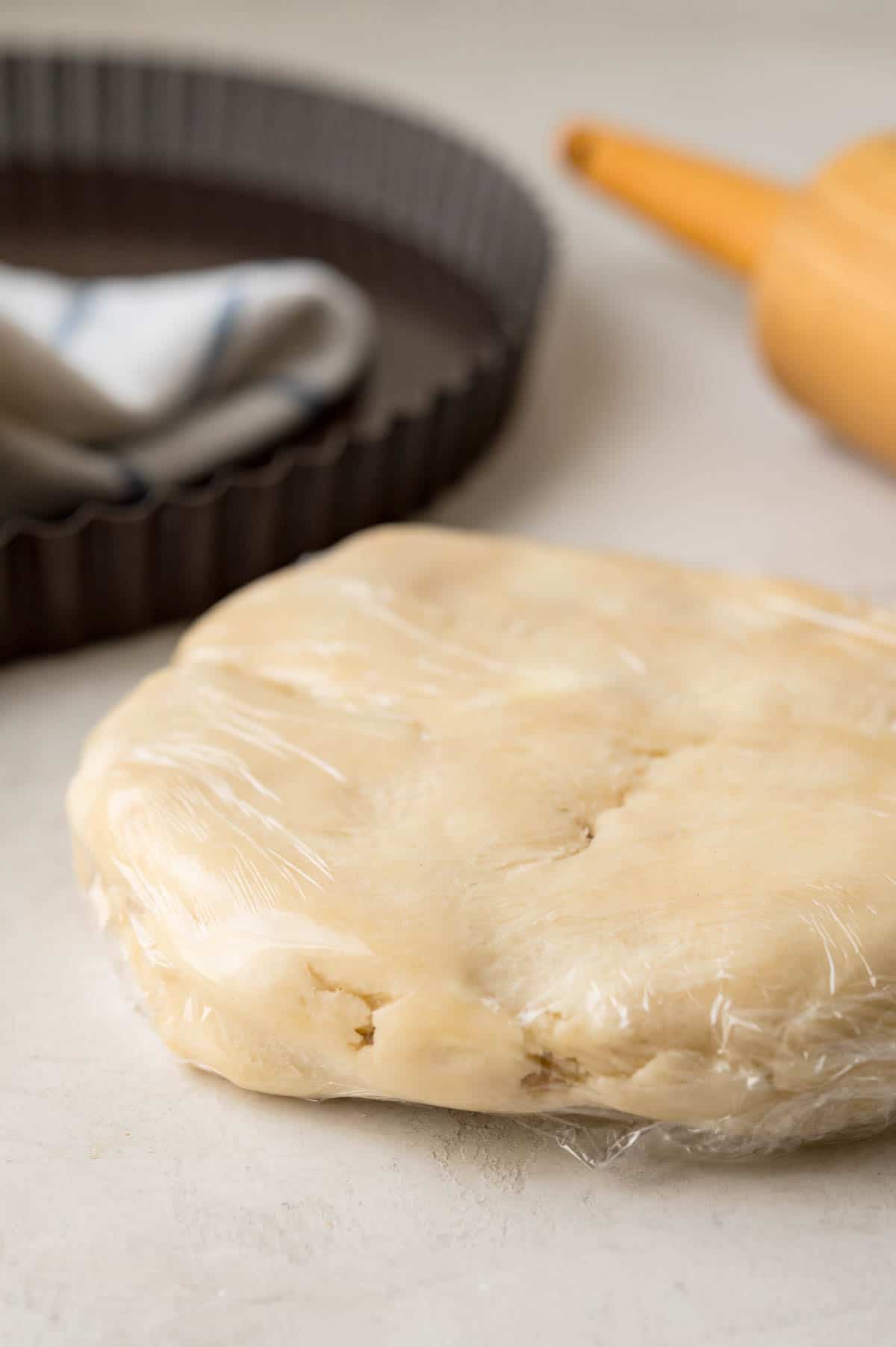
Want an easy pie crust without shortening? This simple cream cheese pastry dough is made in minutes with a food processor. The recipe uses butter and cream cheese for a rich, flaky homemade pie crust that’s perfect for many recipes. I use this cream cheese pie crust for quiche and mini shells for appetizers or bite-sized desserts.
This post contains affiliate links, which means if you make a purchase from a link on the page, you’ll pay no more and I receive a small commission.
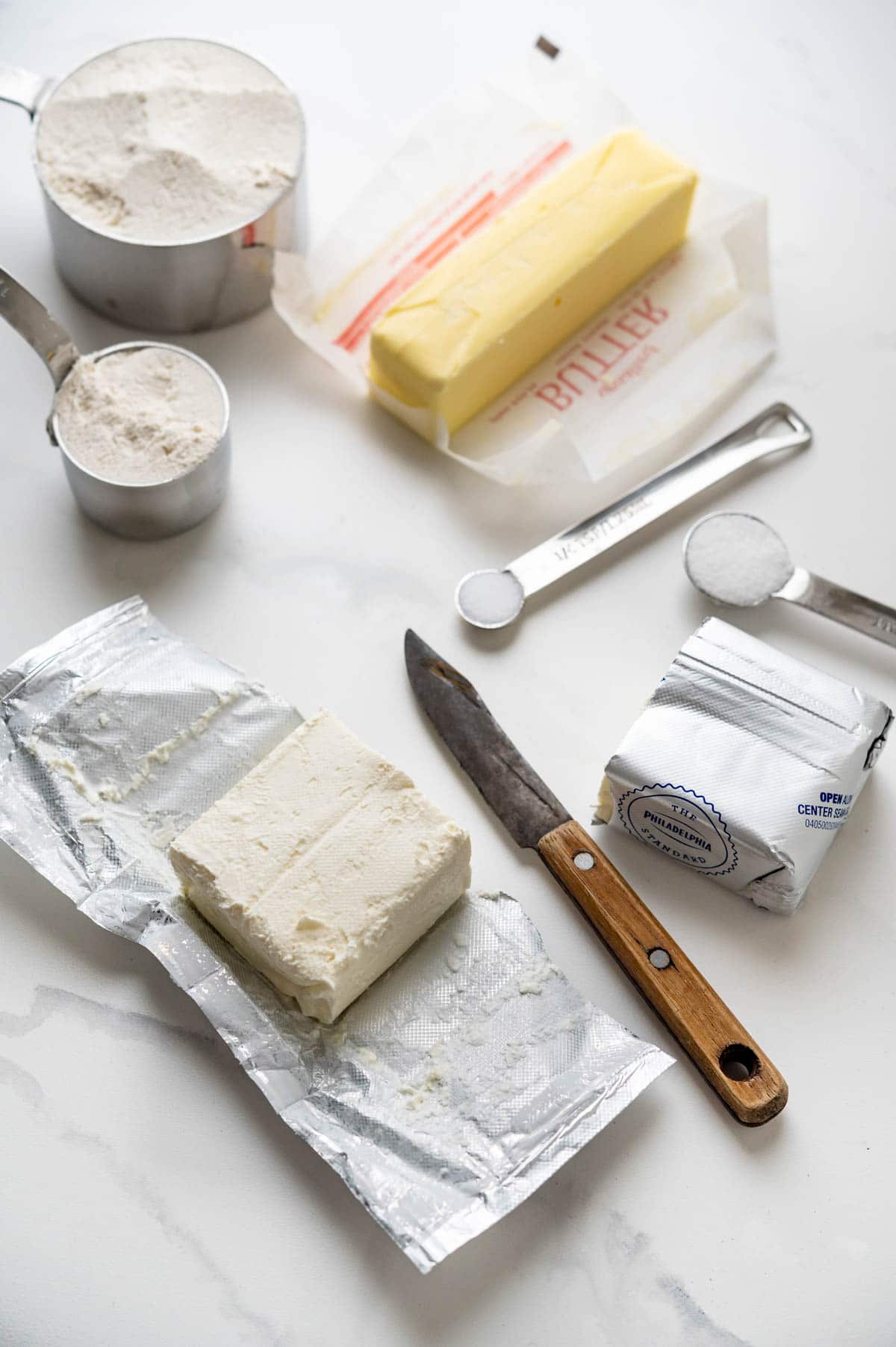
This recipe came from the King Arthur Flour Baker’s Companion Cookbook {affiliate link}. It’s a tome I go to regularly because the recipes are reliable and tasty. And they’ve got my back when I’m looking for a basic but foolproof baking recipe (because baking is a science).
Table of Contents
Homemade cream cheese pie crust
I regularly use this cream cheese pastry dough because it makes a tender, flaky pie crust perfect for everything from mini pies shells for my favorite bite-sized lemon tarts to full-sized savory quiches and mini appetizers (like this mushroom tart recipe).
You’ll love this cream cheese pie crust because it comes together in seconds using a food processor (or you can use a pastry blender and do it by hand, (you know, old-school).
Ingredients:
- Butter – Use cold butter for this recipe.
- Cream Cheese – I used Philadelphia brand. Be sure it’s very cold.
- Sugar – for just a touch of sweet.
- Salt – use regular iodized salt, not kosher.
- All Purpose Flour – I recommend unbleached flour. My favorite is from King Arthur.
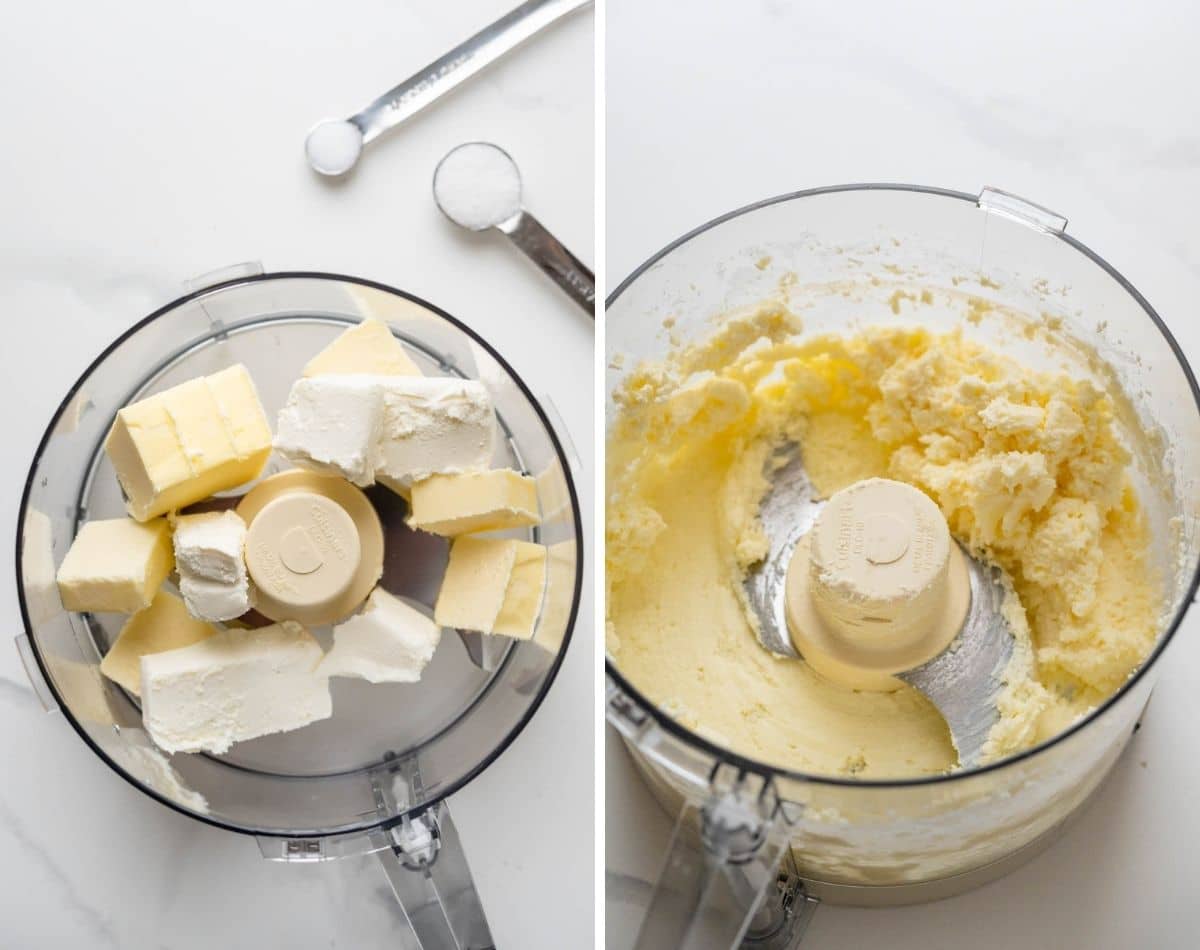
I love this method of making pie crusts in a food processor. The ingredients come together in seconds, and the work is minimal. The dough is a bit sticky at first, so it’s important to refrigerate it before rolling it out.
How to make pie crust in a food processor
- Add the butter and cream cheese to the food processor, then add the sugar and salt.
- Blend until the mixture is very smooth (you may need to scrape down the sides of the food processor once or twice).
- Add the flour and pulse in short bursts until the dough forms a loose ball.
- Transfer the dough to a large piece of plastic wrap.
- Form the dough into a ball, then flatten it into a disc.
- Wrap the dough with plastic wrap and refrigerate for 30 minutes before rolling it out.
How to make pie crust without a food processor
- Cut the cold butter and cold cream cheese into ¼-inch pieces and transfer them to a mixing bowl.
- Add the flour, sugar and salt.
- Use a pastry cutter to cut and blend the ingredients together until they resemble small peas. You should be able to pinch the dough and the pieces will stick together.
- Form the dough into a ball and transfer it to a piece of plastic wrap.
- Flatten the dough into a disc about 1″ thick.
- Wrap the cream cheese pastry in plastic wrap and refrigerate for 30 minutes.
Note: You can make the dough up to 3 days ahead of time and keep it refrigerated. If the dough has been refrigerated for over 1 hour, let it rest on the countertop for 15 minutes before rolling it out. (It’ll be easier this way).
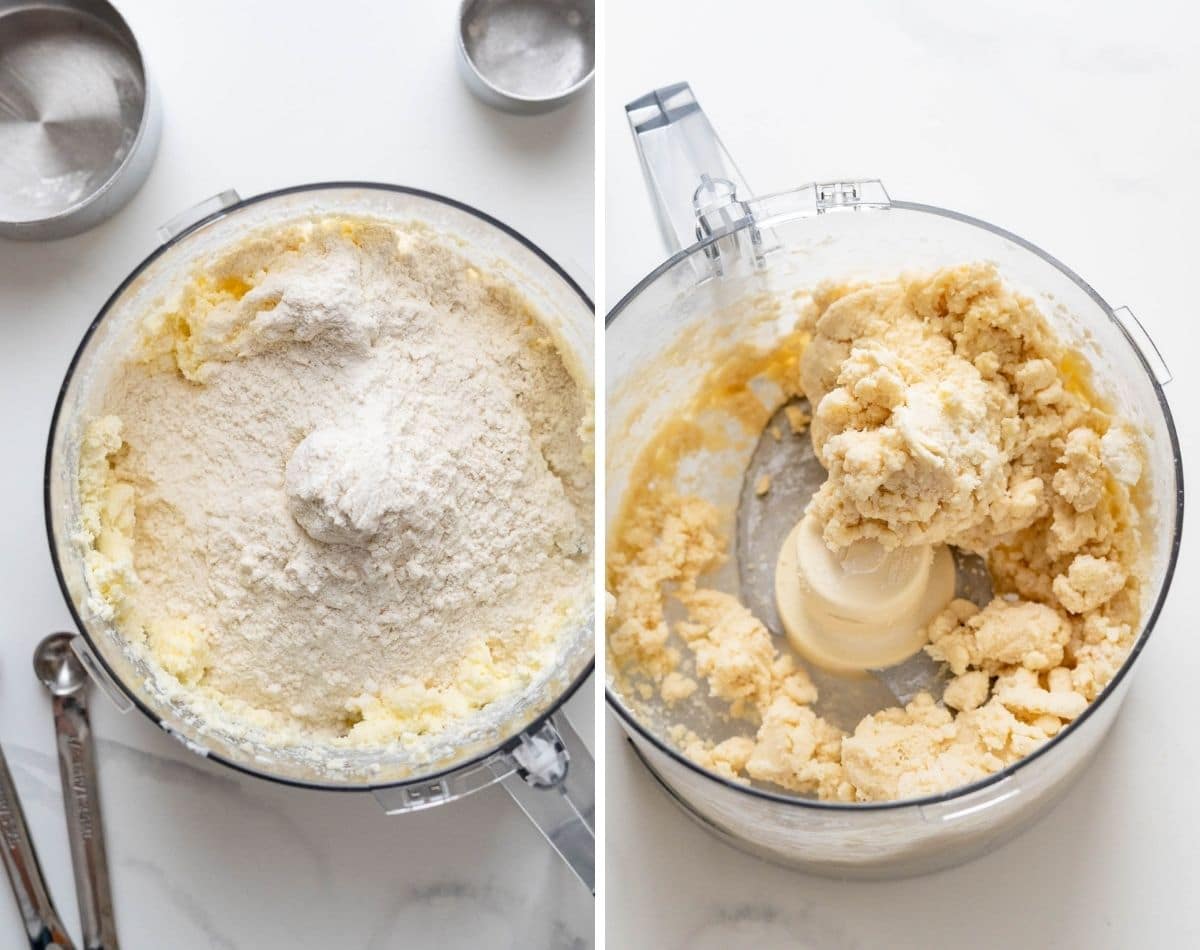
Why does pie pastry dough need to chill and rest before rolling it out?
According to the Noble Pig, Chilling the dough allows the gluten strands to relax, making the cream cheese pie dough easier to roll and preventing shrinking while it bakes.
Common mistakes to avoid
- Warm Ingredients – Make sure your ingredients are cold to start — especially if you live in a warm climate or a particularly humid day.
- Over-processing the pie crust in the food processor – You want to process the cold butter and cream cheese until smooth without warming the dough. Additionally, when adding the flour, use very short pulses to combine the dough mixture (less than one second). This won’t be an issue if you make cream cheese pie crust by hand.
- The cream cheese pastry dough shouldn’t be too wet or too dry. We’re going for Goldilocks territory here — just right. If it is too wet, the dough will be sticky and difficult to roll out. If it’s too dry, the dough will be crumbly. It should feel moist or tacky to the touch. If it’s too wet, add a skosh more flour; if it is too dry, add a little ice water (by the teaspoon).
- Chill and rest the dough – Refrigerating the cream cheese pie crust for 30 minutes will chill the dough enough to make it firm and easier to roll.
- Dough sticking to the countertop and rolling pin – There are many reasons why this can occur, from the dough being too wet (see above) to the ambient air being too warm or humid.
How to combat dough sticking to the counter top:
- Generously flour both the work surface, the top of the cream cheese pastry and the rolling pin so the pie dough doesn’t stick.
- You can use a chilled marble board to roll the dough on. (Chilled marble will hold the cold temperature and make it easier to roll out the pastry).
- If you don’t have a marble board, you can lay frozen icy packs on your work surface for 10-15 minutes to chill the counter (works best with stone, granite or quartz countertops). Be sure to dry any condensation on the work surface and then flour the work surface and proceed with the dough.
- If you want to add less flour, use my go-to method: Sandwiching the dough between two pieces of plastic wrap and rolling it out. You’ll want to lift the plastic and flip the dough around a few times while rolling, but this method is easy, and you don’t have a mess to clean up on your countertop.
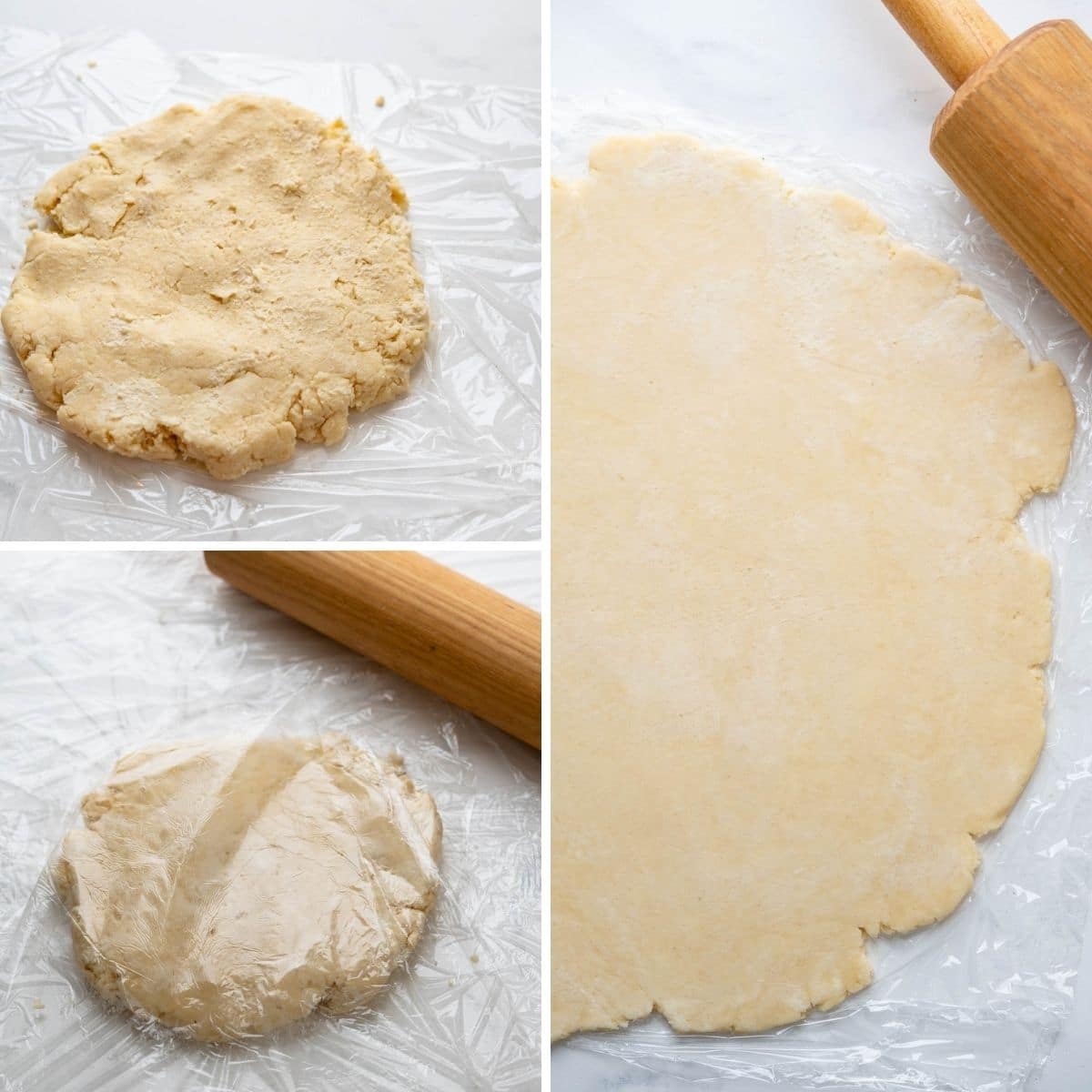
Depending on what you’re making with the cream cheese pastry, you’ll want to roll the dough to different thicknesses.
How thick should I roll out the pie crust for quiche?
For larger tarts or pie crust, roll the dough to about ?” to ¼” thick. (I use a ruler for this, but they also make rolling pins that will guide you to the perfect thickness for whatever you’re doing.
How thick should I roll out the cream cheese pastry for mini pie shells?
For mini tartlets, try to go a little on the thin side. Otherwise, the crust ratio to the filling can be “off.” I recommend slightly under ?” thick.

How to make mini pie shells
Making mini pie shells or tartlets is easy with the right equipment. To make it easier to manage, I like to cut the cream cheese pastry into four equal rounds of dough, flatten them into discs and wrap them individually.
This allows you to work with one crust at a time while keeping the rest of the pastry rounds cold in the refrigerator.
Tools for making tartlet shells
- Rolling pin that measures dough thickness
- Mini muffin tin
- Mini biscuit cutter
- Dough tamper
For mini pie shells using muffin tins, I prefer to use a biscuit cutter about ½ to 1″ wider than the diameter of the muffin well.
- Cut out rounds with the biscuit cutter.
- Transfer to the muffin tin.
- Use a tart tamper or the flat end of a cocktail muddler to press the tart shell to the bottom of the pan.
One recipe of this cream cheese pie crust will make about 48 mini tartlet shells (shown here) or one 9″ pie/tart crust.

Do I need to par-bake the crust?
No. If you have a filling that needs to be baked anyway, fill the uncooked pie or tartlets with the filling and bake as usual.
Tartlets take about 10-12 minutes in a 400° oven. It should take about 20-30 minutes for larger pies, depending on the filling.
What if the filling doesn’t need to be baked?
For normal-sized pies: You can blind-bake the cream cheese pie dough, but you’ll want to use some pie weights or dried beans to keep the shape of the crust intact. Here’s how:
- Place a piece of parchment paper over the crust, including the edges.
- Fill the crust with pie weights or dried beans.
- Spread them out evenly in the shell.
- Bake for 20-25 minutes or until the shell is set and lightly browned.
For mini tarts: Pie weights make little sense, but the cream cheese pastry will puff a bit when cooking.
For this type of shell, I recommend baking the mini pie crusts for 9-10 minutes, then immediately remove them from the oven and use your tamper tool again to press down into the shell cavity. Because the mini pie shells are still warm, they will accept the pressure without cracking.
FAQ’s
You can store the unbaked pastry dough for up to 3 days, well wrapped in the fridge. After that, it starts to get darker and oxidize.
Yes, it will store (well-wrapped) frozen for up to 4-6 weeks. Defrost and chill before rolling out according to the directions above.
Absolutely. This flaky all-purpose dough is excellent for both sweet and savory fillings.
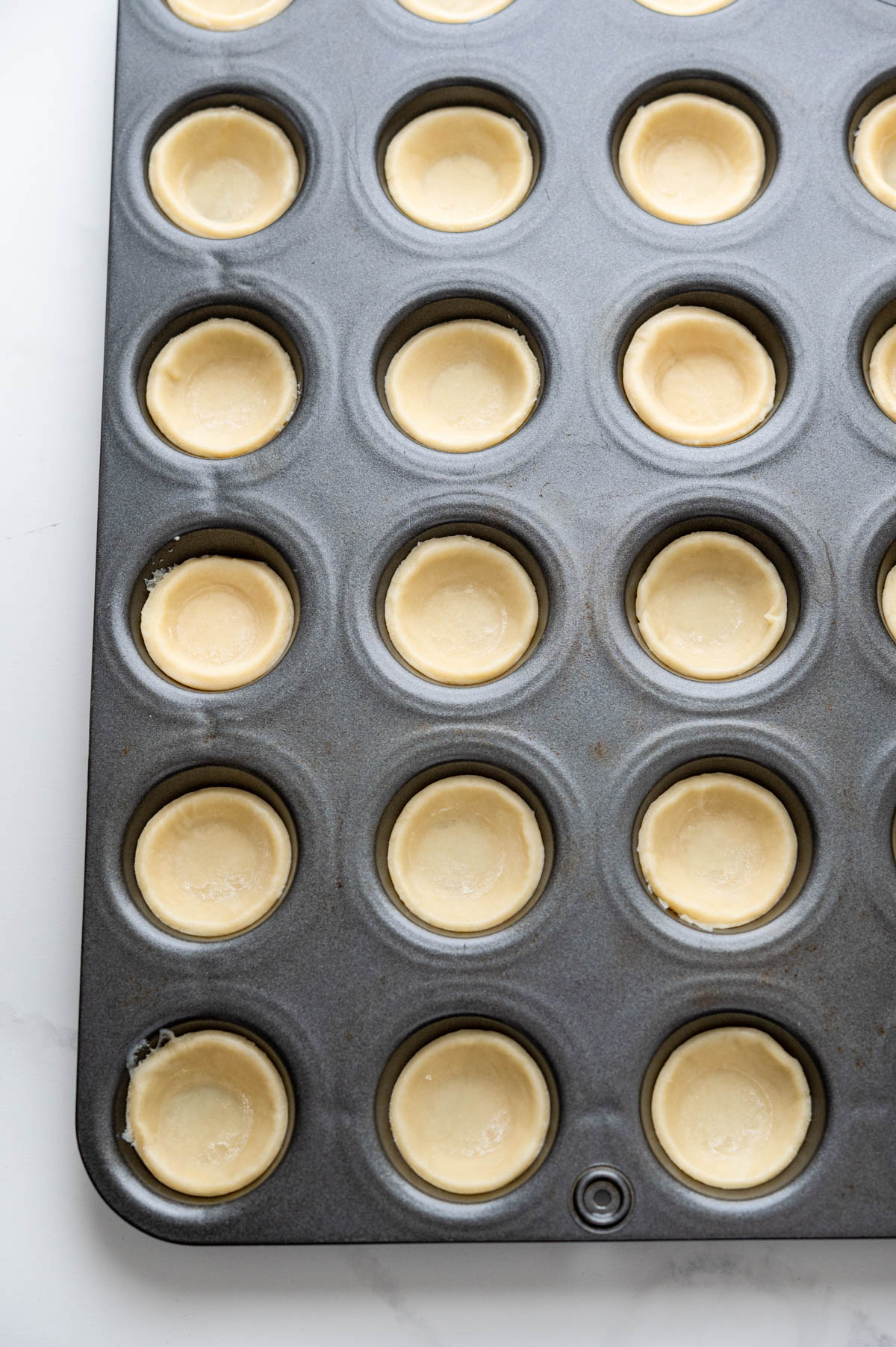
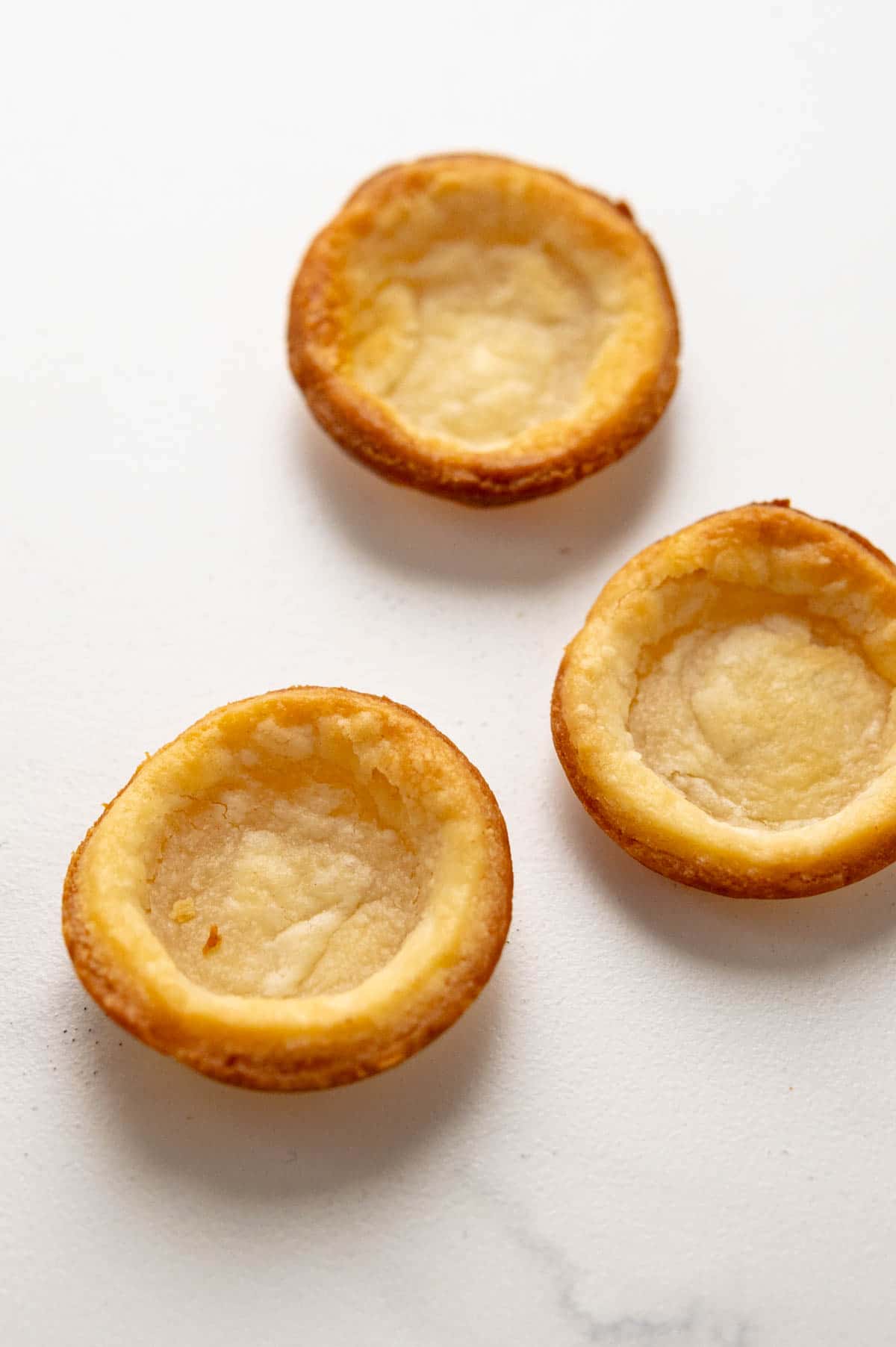

Tried this recipe? Leave a rating and review.
Your comments and shares are invaluable to me and the thousands of readers who use this site daily. If you've made the recipe, leave a star rating and review. We want to hear how you liked it.
We'd love it if you shared the recipe with your friends on social media!
Cream Cheese Pastry Dough
SPECIAL EQUIPMENT:
- Food Processor
- Rolling Pin
- Mini Biscuit Cutter (if you’re making mini tarts)
- Mini Tart Pans (for making mini tarts)
- Pie Plate or Tart Pan with Removable Bottom (for making full size pies/tarts)
INGREDIENTS:
- ½ cup cream cheese (Half of an 8 ounce block)
- ½ cup unsalted butter (1 stick, 8 tablespoons)
- 1 teaspoon sugar
- ¼ teaspoon salt
- 1 ¼ cups all purpose flour
DIRECTIONS:
- Cut the butter and cream cheese into chunks and transfer to the bowl of a food processor. Add the sugar and salt and pulse to blend until the mixture is smooth and creamy.
- Add the flour to the butter mixture and pulse in short bursts until the dough starts to come together in a loose ball. (Don’t over-process)
FOR FORMING AN INDIVIDUAL TART:
- Bring the dough together with your hands and roll into a ball. Pat into a 1″ thick round disc and wrap in plastic wrap. Refrigerate for 30 minutes.
- Note: you can make the dough to this point and keep it refrigerated for up to 3 days. If you chill the dough for longer than one hour, let it rest at room temperature before rolling it out (it will be easier to roll if you let it rest first.)
TO ROLL OUT PASTRY FOR A SINGLE TART/PIE CRUST:
- Generously flour your work surface. Lightly flour the rolling pin and sprinkle a little flour on top of the cream cheese pastry.
- Start with the rolling pin in the center of the dough and roll out towards the edge. Rotate the dough, clockwise and continue to roll from the center to the edge. Do not roll the rolling pin back and forth – it can confuse the dough.
- Add more flour as needed, but try not to use too much.
- To transfer the dough to a pie plate or large tart, fold the pastry in half, then fold it again into a quarter. Pick up the dough and place it in the plate or tart pan and unfold it. Gently press the dough to the bottom and sides of the pan.
- Note: I’ve found that folks who live in a cool climate have no problem rolling out pastry, however those who live in the tropics (like me) don’t have the luxury of cold counters and dry climates that make pastry dough more manageable. If you have that problem, or just have issues rolling out dough, try the plastic wrap method below.
Plastic wrap method for rolling dough:
- If you don’t want to add excess flour (and have had trouble with the dough sticking to the counter top) use the plastic wrap “sandwiching method”. Simply sandwich the disc of dough between two sheets of plastic wrap. The dough won’t stick to the counter or your rolling pin and you can easily lift and reset the plastic wrap on the pastry as you continue to roll it out. Here’s how:Place the dough on a large sheet of plastic wrap and lay another sheet over it, so the cream cheese pastry is sandwiched between them.Roll out the dough from the center to the edge, rotating clockwise after each pass with the rolling pin and lifting the plastic wrap and resettling it each time.Continue in this method until the dough is the right thickness (about 1/4 to 3/8″ thick)To transfer to a pie plate, remove the top layer of plastic wrap and invert it to the pie plate. Remove the second layer of plastic and gently press the crust bottom and sides into the pie plate or tart shell. Form or trim the edges of the crust, fill and bake for 20-25 minutes.
FOR FORMING MINI TARTLETS:
- Divide the dough into 4 and form each into round discs about 1/2″ thick. Wrap in plastic wrap and refrigerate for 20 minutes.
FOR MINI TARTLETS: (About 1 1/2″ in diameter and 1/2″ deep, holds about 2 tablespoons per tartlet)
- Work with one disc of dough at a time. Roll each disc to about 1/8″ thick, rolling from the center to the sides and turning 1/4 turn after each rolling.
- Use a mini biscuit cutter (about 1 1/2 to 2″ wide to cut out the tartlets). Transfer the pastry rounds to a mini tart pan and use a tamper to gently press the pastry to the bottom and sides of the tartlet pans. Bake empty tartlet shells for 8-10 minutes or until light golden brown.
- To bake filled tartlet shells, add your filling (about 1 1/4 to 1 1/2 teaspoonful) and bake for 10-12 minutes or until set.
- You can use this for larger tartlet pans, but you’ll need to adjust the timing depending on how large the tartlets are.
NOTES:
NUTRITION:
Save the pin for later!
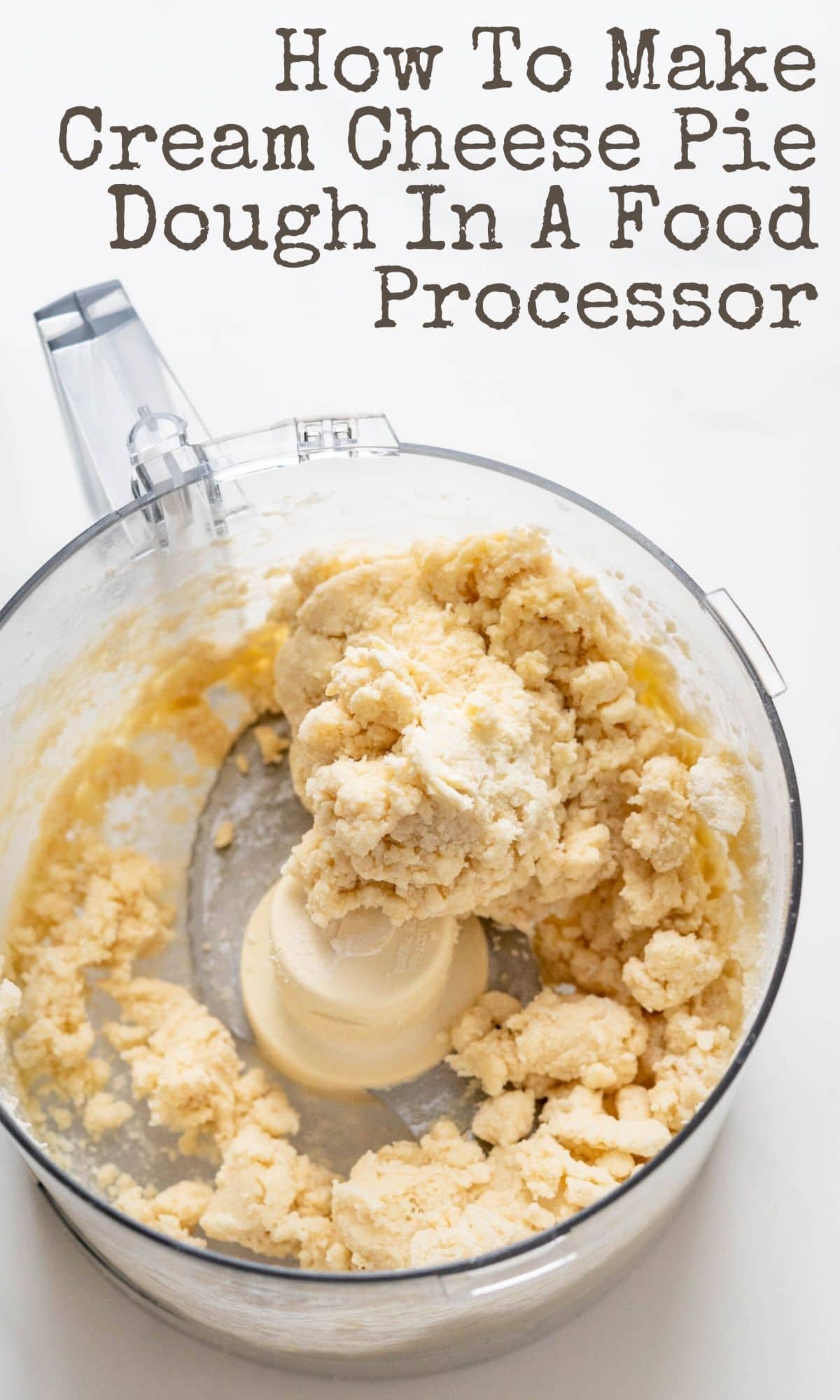

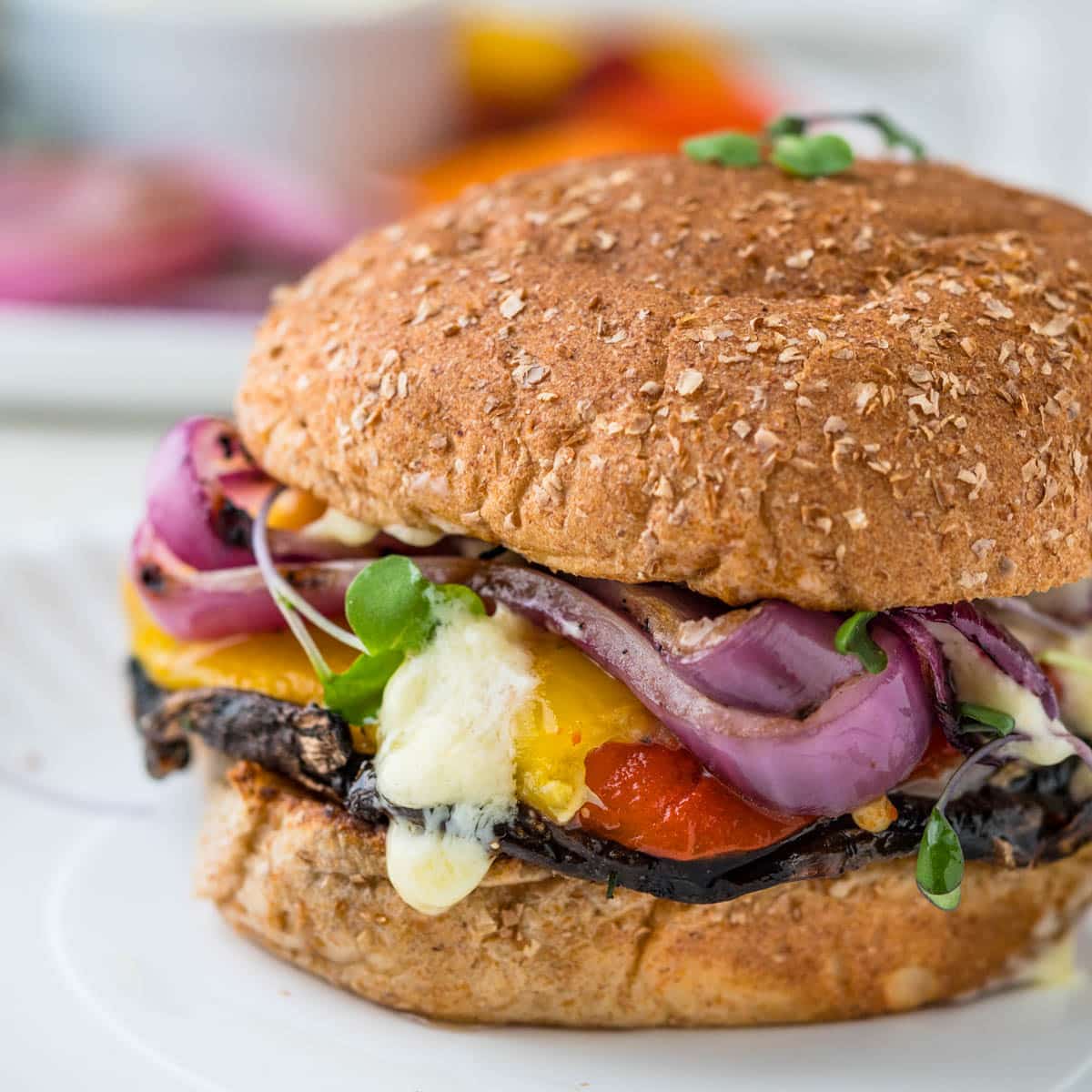
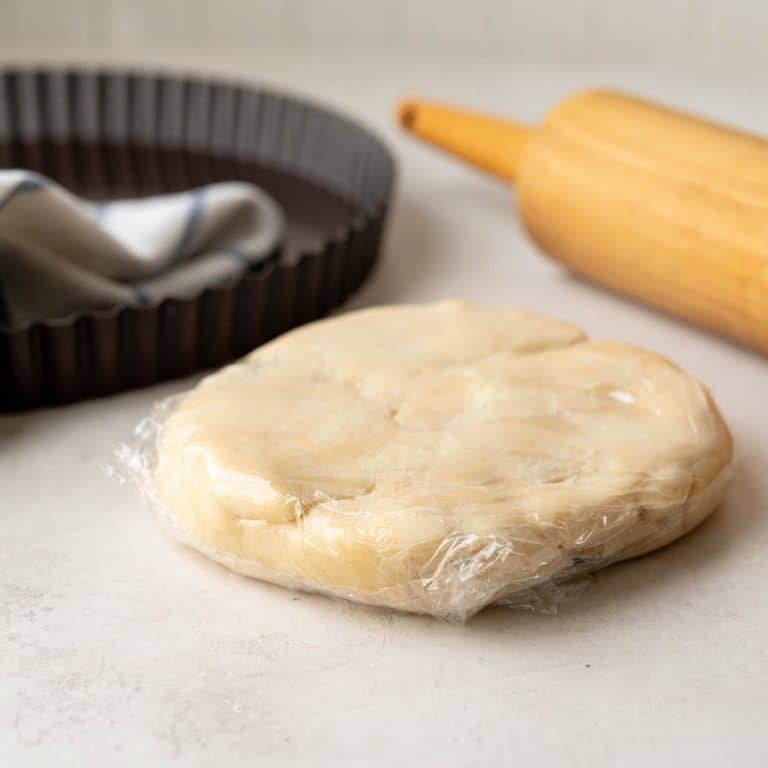
I always buy the packaged stuff but this was easy to work with and produced gorgeous and delicious mini tarts! Thanks, Lisa!